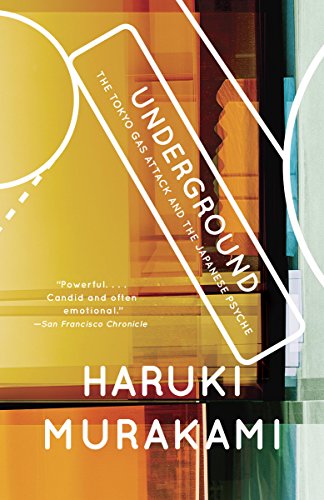

Support BOA by ordering Underground through these links:
Amazon U.S.
Barnes & Noble U.S.
Apple Books U.S.
Amazon Japan
Apple Books Japan
Thanks for helping support Books on Asia!

Underground: The Tokyo Gas Attack and the Japanese Psyche
First published in Japanese in 1997–1998 (as two books) under the name アンダーグラウンド (Andāguraundo)
Translated into English by Alfred Birnbaum and Philip Gabriel in 2000
Note from the BOA Editor: I’ll never forget the morning of March 21, 1995 when I was on my way to teach at university in Okayama, Japan. Every street corner in the city had a policeman standing erect, silent, observing. I didn’t have a TV in my apartment and I certainly didn’t have internet in my abode in 1995. It wasn’t until I reached the university that I learned of the sarin gas attack the previous day. In Tokyo, over 650 kilometers away, 13 people had been killed and thousands injured. At high commute time on the subways, the religious cult Aum Shinrikyo, led by Shōko Asahara (sentenced to death, and executed in 2018), poisoned subway passengers by releasing liquid sarin gas in the subway cars. Naturally, this terrorist attack on their own soil was a shock to the Japanese. For the next week or so, the rest of Japan was on red-alert for any further suspicious activity; even the police in Okayama were omnipresent.
Just like most people know where they were when they heard Princess Diana was killed, John Lennon was shot, or when the Twin Towers were targeted in the 9-11 terrorist attack, most Japanese people know where they were when the Sarin Gas Incident happened in Tokyo’s subway. In his book Underground: The Tokyo Gas Attack and the Japanese Psyche, Haruki Murakami interviews survivors of this incident. This is one of Murakami’s few non-fiction books. To me, this book offers a rare glimpse of the true nature of the Japanese.
Book Description:
Haruki Murakami talks to the people who lived through the catastrophe, and in so doing lays bare the Japanese psyche. As he discerns the fundamental issues that led to the attack, Murakami paints a clear vision of the event.
From the Introduction:
“The Japanese media had bombarded us with so many in-depth profiles of the Aum cult perpetrators—the ‘attackers’—forming such a slick, seductive narrative that the average citizen—the ‘victim’—was an afterthought … which is why I wanted, if at all possible, to get away from any formula; to recognise that each person on the subway that morning had a face, a life, a family, hopes and fears, contradictions and dilemmas—and that all these factors had a place in the drama.
Furthermore, I had a hunch that we needed to see a true picture of all the survivors, whether they were severely traumatized or not, in order to better grasp the whole incident.”
